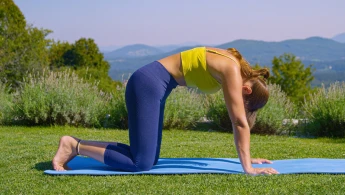Download a Free Spinal Stenosis Physical Therapy Exercises PDF
June 24, 2024
7 min. read

Helping patients with spinal stenosis manage their condition effectively can significantly improve their quality of life. In this article, we'll take an in-depth look at spinal stenosis, top exercises for treating it, and how using a spinal stenosis physical therapy exercises PDF in your practice can enhance patient care and streamline treatment processes.
Clinicians, including physical therapists (PTs), occupational therapists (OTs), and athletic trainers (ATs), can use the handout below as a guide for creating an effective home exercise program focused on spinal stenosis.
Spinal Stenosis Physical Therapy Exercises PDF
Fill out the form to unlock your free spinal stenosis exercises PDF!
Unlock Resource
How to Use the Spinal Stenosis Physical Therapy Exercises PDF
Initial consultation: Introduce the exercises during the first few sessions to ensure patients understand the correct form and technique.
Customization: Tailor the exercises to fit the specific needs and limitations of each patient, considering their symptoms and severity of spinal stenosis.
Education: Educate patients on the importance of these exercises in managing symptoms and preventing progression. Explain the purpose of each exercise and how it contributes to their overall treatment plan.
When to Use the Spinal Stenosis Exercises PDF
Timing is crucial for maximizing the benefits of these exercises.
Early stages of diagnosis: Introduce the exercises as soon as spinal stenosis is diagnosed to start managing symptoms early.
During flare-ups: Use the handout to provide patients with tools to manage pain and stiffness during acute flare-ups.
Post-surgery rehabilitation: For patients recovering from surgery, these exercises can aid in restoring mobility and strength, promoting faster recovery.
Why to Use the Spinal Stenosis Exercises PDF
Efficiency: Saves time in creating and explaining exercises, allowing for more focused treatment sessions.
Patient engagement: Provides patients with clear, easy-to-follow instructions, increasing adherence to HEPs.
Outcomes: Enhances patient outcomes through consistent, targeted exercise routines that address the specific needs of spinal stenosis patients.
Detailed Exercise Descriptions for Spinal Stenosis Management
Here are the spinal stenosis exercises from our spinal stenosis physical therapy exercises PDF:
Seated Lumbar Flexion Stretch
Setup: Begin sitting in a chair with your knees spread apart.
Movement: Bend forward, letting your arms hang toward the ground until you feel a stretch in your lower back.
Tip: Keep movements slow and controlled, do not rise up off the chair when bending forward.
Child's Pose with Sidebending
Setup: Begin on all fours.
Movement: Sit your hips back, reaching your hands forward and to the side, then sink further into the stretch. Hold, then repeat on the other side.
Tip: Relax into the pose, sitting your bottom back to your heels as much as possible.
Self-Traction Sitting
Setup: Sit in a chair with your hands on the armrests or the seat.
Movement: Gently push down with your hands, shifting your weight to your arms until you feel relief. Rise slightly from the chair if needed.
Tip: Ensure your movements are controlled.
Seated Quadratus Lumborum Stretch in Chair
Setup: Sit upright in a chair.
Movement: Lean forward, placing your weight on one arm, then reach across with the opposite arm and sidebend toward the reaching hand. Repeat with the other arm.
Tip: Feel a stretch in the low back on the opposite side of your stabilizing arm.
Supine Dead Bug with Leg Extension
Setup: Lie on your back with knees bent and feet flat on the floor.
Movement: Tighten abdominals, lift legs to a 90-degree angle, arms up toward the ceiling. Lower one arm overhead while straightening the opposite leg, then return to the starting position. Repeat with the other arm and leg.
Tip: Keep abdominals tight and back flat on the floor.
Conditions Treated by Spinal Stenosis Physical Therapy Exercises
Spinal stenosis primarily affects the spinal canal, leading to nerve compression. Understanding the conditions that these exercises target helps in applying them effectively.
Lumbar Spinal Stenosis
Lumbar spinal stenosis occurs due to degenerative changes in the spine, including disc herniation, bone spurs, and thickened ligaments. These changes lead to the narrowing of the spinal canal, causing nerve compression. Patients with lumbar spinal stenosis often experience lower back pain, sciatica, numbness, and weakness in the legs. The symptoms tend to worsen with prolonged standing or walking. If left untreated, lumbar spinal stenosis can result in progressive nerve damage, loss of motor function, and severe chronic pain.
Cervical Spinal Stenosis
Cervical spinal stenosis, similar to lumbar stenosis, is often caused by aging, arthritis, or trauma. This condition leads to the narrowing of the spinal canal in the neck region, resulting in nerve compression. Patients with cervical spinal stenosis typically experience neck pain, shoulder pain, and radiating pain in the arms and hands. In severe cases, it can lead to myelopathy, characterized by difficulty in walking and coordination issues. If untreated, cervical spinal stenosis can cause permanent nerve damage, loss of bladder and bowel control, and significant disability.
While lumbar and cervical spinal stenosis are the primary conditions addressed with spinal stenosis exercises, there are other related conditions and scenarios where these exercises can be beneficial. Here are additional conditions that can be managed with spinal stenosis exercises:
Thoracic Spinal Stenosis
Although less common, thoracic spinal stenosis occurs in the mid-back region. It is caused by similar degenerative changes, such as disc herniation, bone spurs, and thickened ligaments, leading to the narrowing of the spinal canal in the thoracic spine. Symptoms include mid-back pain, radiating pain around the rib cage, and neurological symptoms like numbness, tingling, and weakness in the legs. If untreated, it can lead to severe neurological deficits, including paraplegia.
Degenerative Disc Disease
This condition involves the breakdown of the intervertebral discs, leading to loss of disc height and increased pressure on the spinal nerves. It can result in chronic back pain, stiffness, and reduced mobility. Spinal stenosis exercises help maintain spinal flexibility, reduce pain, and improve function.
Spondylolisthesis
Spondylolisthesis occurs when one vertebra slips forward over the one below it, often due to degenerative changes or congenital abnormalities. This can cause spinal stenosis and nerve compression, leading to back pain, leg pain, and neurological symptoms. Exercises aimed at strengthening the core and stabilizing the spine are beneficial in managing symptoms.
Herniated Disc
A herniated disc can occur in any part of the spine and leads to nerve compression, similar to spinal stenosis. Symptoms include localized pain, radiating pain, numbness, and weakness in the affected area. Spinal stenosis exercises can help alleviate these symptoms by improving spinal alignment and reducing nerve pressure.
Post-Surgical Rehabilitation
Patients who have undergone spinal surgery, such as decompression surgery for spinal stenosis, benefit from these exercises as part of their rehabilitation program. The exercises aid in restoring mobility, strength, and function, promoting faster recovery and preventing recurrence of symptoms.
General Spinal Health and Preventive Care
Regular performance of spinal stenosis exercises can be part of a preventive care routine to maintain overall spinal health, especially in individuals at risk of developing degenerative spinal conditions. These exercises help improve flexibility, strength, and posture, reducing the likelihood of developing severe spinal issues.
Incorporating these exercises into treatment plans for various spinal conditions can significantly improve patient outcomes, enhance quality of life, and prevent the progression of symptoms.
Taking Spinal Stenosis Care to the Next Level
Medbridge Home Exercise Program allows you to take your patient care to the next level with over 8,000 video-based exercises combined with powerful program building and patient management capabilities such as smart search, customizable templates, one-click documentation, and patient feedback tracking. Equip your practice with the best tools for managing spinal stenosis by downloading our printable exercise PDF and exploring our extensive HEP library.





